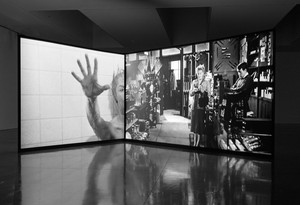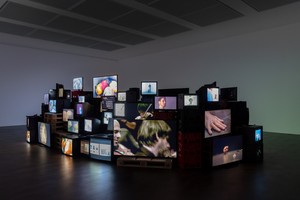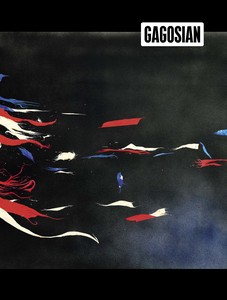
Douglas Gordon
Katrina Brown discusses the importance of Douglas Gordon’s 24 Hour Psycho (1993) and some of the films that followed, touching on threads that run throughout the artist’s career.
Extended through February 3, 2018
If you want to find the truth in something, take it apart piece by piece, then put it back together with the detail of a forensic scientist. This is a classical way to deconstruct a narrative. However, when you stand in front of 24 Hour Psycho (1993) slowly unfolding piece by piece, after five minutes, you’ve lost track of where the narrative started. I like this idea that you can take almost a scientific method and end up lost in a labyrinth of multiple, conflicting meanings, and that you have to acknowledge your own forgetfulness.
—Douglas Gordon
Gagosian is pleased to present back and forth and forth and back, an exhibition of key films and videos by Douglas Gordon, including 24 Hour Psycho Back and Forth and To and Fro (2008), as well as a selection of video monitor works.
In his projections, installations, photographs, text works, performances, and more, Gordon investigates collective memory and selfhood, whether divided, fragmented, or dissolved altogether. His interest in temporal manipulation is especially evident in his films and videos; using his own work and that of others as raw material, he distorts time in order to disorient and challenge.
For 24 Hour Psycho Back and Forth and To and Fro (2008), Gordon exacerbates the already unsettling plot of Alfred Hitchcock’s iconic thriller Psycho (1960) by allowing time to flow forward and backward at the same time. While Gordon’s earlier 24 Hour Psycho (1993) slowed down Hitchcock’s original to a few frames per second, extending the duration of the film to twenty-four hours, 24 Hour Psycho Back and Forth and To and Fro introduces an additional layer of distortion. The film plays on two adjoining screens: on one, the film starts from the beginning, and on the other it starts from the end, so that for an unbearably brief moment (one twenty-fourth of a second), after waiting for twelve hours, the screens show the same sequence, the mirrored images resembling a giant, slow-moving Rorschach test.
Using edited footage as a malleable resource, Gordon sets up new definitions of suspense and climax. Rather than waiting for Janet Leigh’s killer to appear in silhouette, knife in hand, behind her, viewers of Gordon’s film enter a hypnotic and photographic spectacle with the hope of simply catching the split second when two temporal directions overlap.

Katrina Brown discusses the importance of Douglas Gordon’s 24 Hour Psycho (1993) and some of the films that followed, touching on threads that run throughout the artist’s career.

On the occasion of Douglas Gordon: All I need is a little bit of everything, an exhibition in London, curator Adam Szymczyk recounts his experiences with Gordon’s work across nearly three decades, noting the continuities and evolutions.
Douglas Gordon took over the Piccadilly Lights advertising screen in London’s Piccadilly Circus, as well as a global network of screens in cities including Berlin, Melbourne, Milan, New York, and Seoul, nightly for three minutes at 20:22 (8:22pm) throughout December 2022, with his new film, if when why what (2018–22). The project was presented by the Cultural Institute of Radical Contemporary Art (CIRCA) in conjunction with the exhibition Douglas Gordon: Neon Ark at Gagosian, Davies Street, London.

The Spring 2018 Gagosian Quarterly with a cover by Ed Ruscha is now available for order.
Featuring an extensive interview with Douglas Gordon on the process of making his 2016 film I had nowhere to go: Portrait of a displaced person, this video, produced by Berlin Art Link, includes clips of Jonas Mekas and revealing anecdotes about the creation of the film.
Douglas Gordon and Morgane Tschiember’s installation As close as you can for as long as it lasts, presented during Elevation 1049: Avalanche in Gstaad, Switzerland.
Douglas Gordon and Rufus Wainwright collaborated to produce afflictive, slow-motion projections to accompany Wainwright’s performances during his 2010 All Days Are Nights: Songs for Lulu tour.